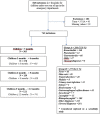Breastfeeding and respiratory, ear and gastro-intestinal infections, in children, under the age of one year, admitted through the paediatric emergency departments of five hospitals
- PMID: 36874253
- PMCID: PMC9975383
- DOI: 10.3389/fped.2022.1053473
Breastfeeding and respiratory, ear and gastro-intestinal infections, in children, under the age of one year, admitted through the paediatric emergency departments of five hospitals
Abstract
Background: Breastfeeding is a protective factor against respiratory and intestinal infections in developing countries. In developed countries, proof of this protection is more difficult to show. The objective of the study is to compare the proportion of children breastfed during their first year in groups of children with infectious pathologies supposedly prevented by breastfeeding and children free of these infectious pathologies.
Method: Questionnaires about diet, socio-demographic data and the motive for consultation were given to the parents upon arrival in the paediatric emergency departments of 5 hospitals located in Pays de Loire (France) in 2018 and 2019. Children with lower respiratory tract infections, acute gastroenteritis and acute otitis media were included in the case group (A), children admitted for other reasons were included in the same control group (B). Breastfeeding was classified as exclusive or partial.
Results: During the study period, 741 infants were included, of which 266 (35.9%) in group A. In this group, children were significantly less likely to have been breastfed at the time of admission than children in group B: for example, for children under 6 months, 23.3% were currently breastfed in group A, vs. 36.6% (weaned BF or formula diet) in group B [OR = 0.53 (0.34-0.82); p = 0.004]. Similar results were found at 9 and 12 months. After taking into account the age of the patients, the same results were confirmed with an aOR = 0.60 (0.38-0.94) (p = 0.02) at 6 months, but with when considering six variables six variables, aOR was not significative aOR = 0.65 (0.40-1.05); p = 0.08), meaning that factors such as the childcare out of home, socio-professional categories, and the pacifier decrease the protective effect of breastfeeding. Sensitivity analyses (age-matching, analysis by type of infection) showed the same protection effect provided by breastfeeding when it was pursued for at least 6 months and also that the protective effect of breastfeeding is especially true against gastro-enteritis.
Conclusion: Breastfeeding is a protective factor against respiratory, gastrointestinal and ear infections when pursued at least 6 months after birth. Other factors such as collective childcare, pacifiers and low parental professional status can reduce the protective effect of breastfeeding.
Keywords: breastfeeding; gastro-intestinal infections; multicentric study; protective effect; respiratory infections.
© 2023 Branger, Bainier, Martin, Darviot, Forgeron, Sarthou, Wagner, Blanchais, Brigly and Troussier.
Conflict of interest statement
The authors declare that the research was conducted in the absence of any commercial or financial relationships that could be construed as a potential conflict of interest.
References
-
- ELFE De, Lauzon-Guillain B, Projet Sofi, Cress Inserm. Alimentation lactée dans la 1ère année: état des lieux. 15 p. Available from: http://www.elfe-france.fr/images/documents/Alimentation-lactee-France_JS...
-
- Elfe Niklaus S, Ksiazek E, Bournez M, De Lauzon-Guillain B, Tichit C. Déterminants de la conduite de la diversification alimentaire. (2017). 26 p. Available from: http://www.elfe-france.fr/images/documents/Determinants-diversification-...
-
- Salanave B, De Launay C, Boudet-Berquier J, Guerrisi C, Castetbon K. Alimentation des nourrissons pendant leur première année de vie Résultats de l’étude Epifane 2012–2013. Saint-Maurice: Institut de veille sanitaire. 61 p.. Available from: http://opac.invs.sante.fr/doc_num.php?explnum_id=10631
-
- Salanave B, De Launay C, Boudet-Berquier J, Castetbon K. Durée de l’allaitement maternel en France (Epifane 2012–2013). Bull Epidemiol. Hebd (2014) 27. http://invs.santepubliquefrance.fr/beh/2014/27/pdf/2014_27_2.pdf
-
- Wagner S, Kersuzan C, Gojard S, Tichit C, Nicklaus S, Bertrand Geay, et al. Durée de l’allaitement en France selon les caractéristiques des parents et de la naissance. Résultats de l’étude longitudinale ELFE 2011. BEH. (2015) 29:522–9. https://hal.archives-ouvertes.fr/hal-01203828/document
LinkOut - more resources
Full Text Sources
Miscellaneous


